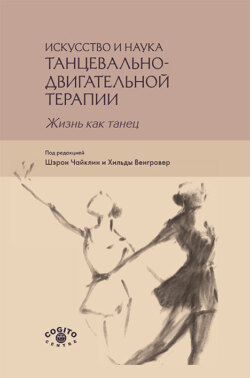Читать книгу Искусство и наука танцевально-двигательной терапии. Жизнь как танец - Ю. Д. Земенков, Koostaja: Ajakiri New Scientist, Koostaja: Egle Saska - Страница 33
Раздел 1. Основные принципы танцевально-двигательной терапии
2. Творческий процесс в танцевально-двигательной терапии. Хильда Венгровер
Литература
ОглавлениеAnzieu D. (1998). El Yo-Piel / Transl. S. Vidarrazaga Zimmermann. Madrid, Biblioteca Nueva (In English: 1989, The skin ego, New Haven, CT: Yale University Press).
Arieti S. (1976). Creativity: The magic synthesis. New York: Basic Books.
Aulagnier P. (1980). El sentido perdido. Buenos Aires: Trieb.
Béjart M. (1973). Préface. In R. Garaudy, Danser sa vie. Paris: Seuil.
Bleger J. (1970). Psicología de la conducta. Buenos Aires: Centro Editor de América Latina.
Buck R., Van Lear C. A. (2002). Verbal and nonverbal communication: Distinguishing symbolic, spontaneous and pseudo-spontaneous behavior. Journal of Communication, 52 (3): 522-541.
Carter C. (2000). Improvisation in dance. The Journal of Aesthetics And Art Criticism, 58 (2): 181-190.
Castoriadis, C. (1992). El psicoanálisis, proyecto y elucidación. Buenos Aires: Nueva Visión.
Chodorow J. (1991). Dance therapy and depth psychology: The moving imagination. London-New York: Routledge.
Cyrulnik B. (2003). Los patitos feos / Transl. T. Fernández Aύz, B. Eguibar. Barcelona: Gedisa.
Dissanayake E. (2000). Antecedents of the temporal arts in early mother-infant interaction // N. L. Wallin, B. Merker, S. Brown (Eds). The origins of music (pp. 389-410). Cambridge, MA: The MIT Press.
Dosamantes-Beaudry I. (2003). The arts in contemporary healing. Westport, CT: Praeger Publishers.
Erikson E. (1963). Toys and reasons // Childhood and society (pp. 209-246). New York: W. W. Norton.
Español S. (2006). Las artes del tiempo en psicología. Actas de la V Reunión de SACCoM, 9-25.
Fairbairn W. R. (1952/1994). Psychoanalytic studies of the personality. London: Routledge.
Fiorini H. (1995). El psiquismo creador. Buenos Aires: Paidós.
Freud S. (1900/1953). Typical dreams, in The Interpretation of Dreams. Standard edition of the Complete psychological works of Sigmund Freud, Vol. 4 (pp. 241-276). London: Hogarth Press.
Freud S. (1908/1973). Creative writers and daydreaming. Standard edition of the Complete psychological works of Sigmund Freud, Vol. 9 (pp. 141–155). New York: International Universities Press [см. русский перевод: Фрейд 3. Художник и фантазирование (сборник работ). – М.: Республика, 1995, с. 128–134].
Freud S. (1910/1953). A special type of object choice. Standard edition of the Complete psychological works of Sigmund Freud, Vol. 11 (pp. 166–175). London: Hogarth Press.
Freud S. (1914/1955). The Moses of Michelangelo. Standard edition of the Complete psychological works of Sigmund Freud, Vol. 13 (pp. 209–238). London: Hogarth Press [см. русский перевод: Фрейд 3. Художник и фантазирование (сборник работ). – М.: Республика, 1995, с. 218–232].
Govoni R. M., Piccioli Weatherhogg A. (2007). The body as theatre of passions and conflicts: Affects, emotions and defenses. Body, Movement and Dance in Psychotherapy, 2 (2): 109–121.
Guilford J. P. (1968). Intelligence, creativity and their educational implications. San Diego, CA: R. R. Knapp.
Hanna J. (2008). A nonverbal language for imagining and learning: Dance education in K-12 curriculum. Educational Researcher, 37 (8): 491–506.
Homs J. (2000). El arte o lo inefable de la representación. Tresalcuarto, 1er semestre, 14–17.
Klein M. (1929). Infantile anxiety situations reflected in a work of art and in the creative impulse. International Journal of Psychoanalysis, 10: 439–444.
Kohut H. (1977). The restoration of the self. New York: International Universities Press.
Kris E. (1952). Psychoanalytic explorations in art. New York: International Universities Press.
Laplanche J., Pontalis B. (1973). The language of psychoanalysis. Oxford: W. W. Norton.
Lewis Bernstein P. (1979). Historical perspective in DMT // Kendall/Hunt (Ed.). Eight theoretical approaches in dance-movement therapy (pp. 3–6). Iowa: Kendall/Hunt.
Nadel M., Strauss M. (2003). The dance experience: Insights into history, culture and creativity. Highston, NJ: Princeton Books.
Noy P. (1969). A theory of art and aesthetic experience. Psychoanalytical Review, 55: 623–645.
Oxford English Dictionary (full edition) (1991).
Press C. (2005). Psychoanalysis, creativity and hope: Forward edge strivings in the life and work of choreographer Paul Taylor. Journal of the American Academy of Psychoanalysis and Dynamic Psychiatry, 33 (1): 119–136.
Rank O. (1907/1973). Art and artist: Creative urge and personality development. New York: A. A. Knopf.
Read H. (1965). Icon and idea: The function of art in the development of human consciousness. New York: Shocken.
Robbins A. (1980). Expressive therapy. New York: Human Sciences Press.
Rosenblatt A. (2004). Insight, working through and practice: The role of procedural knowledge. Journal of American psychoanalytic association, 52 (1): 189–207.
Schilder P. (1950). The image and appearance of the human body. New York: International Universities Press.
Schneider Adams L. (1993). Art and psychoanalysis. New York: Harper Collins.
Stanton Jones, K. (1992). Dance movement therapy in psychiatry. London: Routledge.
Stern D. (1985). The interpersonal world of the infant. New York: Basic Books.
Stern D. (2004). The present moment in psychotherapy and everyday life. New York: W. W. Nor ton.
Stern D. (2010). Forms of vitality: Exploring dynamic experience in psychology and the arts. Oxford: Oxford University Press.
Storr A. (1972/1993). The dynamics of creation. New York: Ballantine Books.
Strenger C. (1998). Individuality, the impossible project: Psychoanalysis and self-creation. Connecticut, CT: International Universities Press.
Strenger C. (2003). The self as perpetual experiment: Psychodynamic comments on some aspects of contemporary urban culture. Psychoanalytic Psychology, 20 (3): 425–440.
Trevarthen C. (1982). The primary motives for cooperative understanding // G. Butterworth, P. Light (Eds). Social cognition (pp. 77–109). Brighton: Harvester.
Watzlawick P., Beavin H., Jackson D. (1967). Pragmatics of human communication, a study of interactional patterns, pathologies and paradoxes. New York: W. W. Norton & Co.
Winnicott D. (1965). The capacity to be alone // Maturational processes and the facilitating environment: Studies in emotional development (pp. 29–36). London: The Hogarth Press and the Institute of Psycho-Analysis.
Winnicott D. (2005). Playing and reality. New York – London: Routledge.
Wosien M. G. (1992). Sacred dance: An encounter with the gods. London: Thames & Hudson.
Zukerfeld R., Zonis Zukerfeld R. (2005). Procesos terciarios: De la vulnerabilidad a la resiliencia. Buenos Aires: Lugar.
